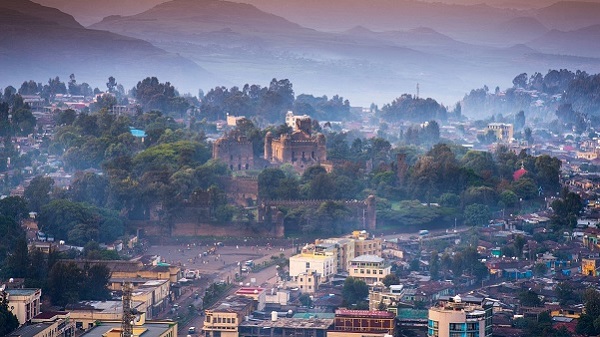
Dubbed the Camelot of Africa, the city of Gondar — capital of Ethiopia from 1636 until the mid 19th century — combines a modern veneer with an architectural sensibility harking back to the Middle Ages. The city’s physical and architectural centerpiece is Fasil Ghebbi, a stone-walled Royal Compound containing half a dozen fairy-tale castles including the three-storey original built by Emperor Fasil in the 1630s. The Fasil Ghebbi UNESCO World Heritage Site also incorporates several more remote constructions, most notably the Church of Debre Berhan Selassie, with its beautifully painted interior.
- Enclosed by tall stone walls, the central Fasil Ghebbi is a 7-hectare ‘Royal Compound’ housing six fortified stone castles built from the 1630s onward. The most striking is Emperor Fasil’s three-storey castle, which stands 32 meters high, and displays a blend of Portuguese, Indian and indigenous Aksumite influences typical of the Gondarine style.
- Consecrated in 1693 under Emperor Iyasu I, Debre Berhan Selassie (‘Mountain of the Enlightened Trinity’) was the only major Gondarine church to survive the Mahdist attack of 1888 unscathed – thanks, legend has it, to the intervention of a virulent bee swarm. The ceiling, adorned with 17th-century paintings of 80 cherubic faces, is probably the most famous ecclesiastic artwork in Ethiopia.
- The sunken Fasil’s Pool, overlooked by a two-storey building attributed to Emperor Fasil, is where Gondar’s legendarily colourful annual Timkat (Ethiopian Epiphany) celebrations take place on January 19 (a day later in Leap Years).
- Named after a Coptic convent in Egypt, the 18th century Kuskuam Palace was constructed on the slopes of Debre Tsehay (Mountain of Sun) for the charismatic Empress Mentewab, wife of Emperor Bakaffa, and regent to their son Iyasu II and grandson Iyaos I.
- On the northern outskirts of Gondar, an abandoned synagogue at Woleka evokes the story of the Beta Israel, a ‘lost tribe’ of Ethiopian Jews whose last 10,000-or-so adherents were airlifted to Israel during the 1980s.
- Old Gorgora, on the Lake Tana shore 65km south of Gondar, houses the most remote of the sites that comprise the Fasil Ghebbi UNESCO World Heritage Site: a ruined castle and Catholic church called Maryam Gimb.
The 14th-century Monastery of Debre Sina Maryam, a monastic church at ‘new’ Gorgora, is decorated with some of Ethiopia’s oldest surviving paintings, executed in the 1620s under the patronage of Melakotawit, the elder sister of Emperor Fasil.
Source: Ethiopian Tourism Organization
